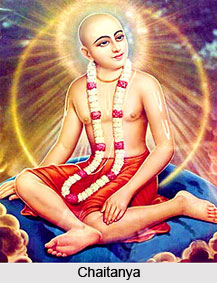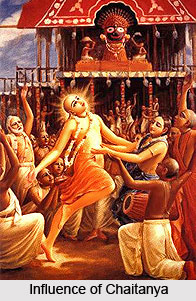 Chaitanya Mahaprabhu was a famous Bhakti saint and social reformer of Eastern India around the 16th century. He was the one who had propounded the school of Vaishnavism all over India. Mainly Lord Chaitanya worshipped Lord Krishna and Radha. It was also believed that Sri Chaitanya was the incarnation of Lord Krishna himself and Chaitanya had also popularised the Hare Krishna Maha Mantra. Chaitanya is known by the name Gaura or the golden one because of his fair complexion and he was also called Nimai because it is believed that he was born under a Neem tree.
Chaitanya Mahaprabhu was a famous Bhakti saint and social reformer of Eastern India around the 16th century. He was the one who had propounded the school of Vaishnavism all over India. Mainly Lord Chaitanya worshipped Lord Krishna and Radha. It was also believed that Sri Chaitanya was the incarnation of Lord Krishna himself and Chaitanya had also popularised the Hare Krishna Maha Mantra. Chaitanya is known by the name Gaura or the golden one because of his fair complexion and he was also called Nimai because it is believed that he was born under a Neem tree.
Etymology of Chaitanya
Chaitanya denotes the essence of consciousness, derived from the term "Chetana," signifying "Consciousness." He was known as Mahaprabhu by his followers. The word “Maha†signifies greatness, and Prabhu pertains to "Lord" or "Master." It is noteworthy that as he was also known as Gauranga or Gaura, attributed to his resplendent complexion akin to molten gold, his birthday is venerated as Gaura-purnima.
Early Life of Chaitanya
Chaitanya was born at Nabadwip in 1486. His father Jagannatha Misra was a religious and scholarly man and his mother Sachi was also a pious and religious minded lady. Chaitanya, as a boy, was an exceptionally brilliant student. At the early age of 15 he had mastered Sanskrit language, literature, grammar and logic. Chaitanya lost his father in his childhood and his elder brother Visvarupa who had followed the life of an ascetic took care of their mother. Chaitanya spent the time as a Grihastha till the age of twenty-four. During this period he married Vishnupriya, the only daughter of Rajapandita Sanatana. When he was 24 years old he lost interest in family life and became a Bairagi. He visited places like Mathura and Puri. In course of his travelling he started preaching and teaching his doctrines, acquiring followers and extending worship of Lord Krishna. He spent six years in pilgrimage and thereafter settled in Puri. At the age of 30 he permanently settled at Puri. He wandered about the country, preaching the doctrine of love and the worship of Krishna. Thousands of residents of Bengal became his followers. Love was a great passion with him that the thought of Krishna playing upon his flute in the wild woods of Vrindavan threw him into an ecstasy.
Philosophy of Chaitanya
Chaitanya believed that Lord Krishna dwells in every soul and, therefore one should give respect to others, without seeking anything for himself. He laid stress on humility and said that a Vaishnava should be absolutely without pride. His heart was full of compassion for the poor and the weak. He used to melt with pity as he saw the sorrows of mankind. He denounced caste and proclaimed the universal brotherhood of man and the worship of Hari as the only means of attaining the highest bliss. He asked his followers to teach the lowest Chandala the lesson of devotion. It was why the high and the low, the Brahmins and the Sudra listened to his message and followed him. For him Vaishnavism was a living force, a rule of life, and not merely a religious principle to be practiced by ascetics and recluses.
Chaitanya`s concern was to exalt the superiority of Krishna over all other Hindu deities. His cult of Krishna was also a movement of Hindu reformation, freeing Hinduism from Brahmanical oppression. He did not want to reform Hinduism by incorporating any features of Islam. He adored Krishna and Radha and attempted to spiritualize their lives in Vrindavan. Radha was conceived as the eternal enjoyed and Krishna as the eternal enjoyer. Radha was conceived not as the wife of Krishna but the beloved of Krishna. He introduced devotional music or kirtan. Every participant in the kirtan was carried away by the torrent of religious excitement. In kirtan all the disciples of Chaitanya whether one was a Brahmin or a low caste Hindu participated. He recognized that the Sudras were equally capable of developing spiritual personality. The followers of Chaitanya passed through the streets of Nabadwip singing and dancing in a procession and devotional songs were sung in every house in Bengal. Thus, Kirtans cemented the bond of unity amongst different castes. Thus it was a revolutionary movement, which brought about unity in Hindu society. But it was a revivalist movement, as it did not borrow any ideas from Islam.
Teachings of Chaitanya
Lord Chaitanya, through his profound teachings, imparted spiritual wisdom and guidance to his followers. His direct teachings are enshrined in Sanskrit verses known as Siksastakam, while he also composed numerous songs celebrating the Radha-Krishna theme, showcasing his poetic and devotional brilliance.
Chaitanya`s teachings encompass a comprehensive understanding of epistemology, theology, and ontology, encapsulated in ten fundamental principles known as dasa mula. These principles serve as the foundation of his philosophical system. The primary basis for Chaitanya`s teachings lies in the statements of amnaya, the sacred scriptures, which hold the highest authority. From these scriptures, nine crucial topics are elucidated:
1. Krishna is the Supreme Absolute Truth, the ultimate reality and the source of all existence.
2. Krishna is imbued with all energies, demonstrating his omnipotence and all-encompassing nature.
3. Krishna is the fountainhead of rasa, referring to the myriad flavors of spiritual rapture and emotions experienced in a loving relationship with the divine.
4. Individual souls, known as jivas, are distinct, eternal parts of the Supreme Lord.
5. In their conditioned state, the jivas become entangled in material existence due to their marginal nature, susceptible to the influence of matter.
6. In a liberated state, the jivas transcend the shackles of material influence, basking in spiritual freedom.
7. The jivas and the material world share both distinctiveness and unity with the Supreme Lord, reflecting the intricacies of their relationship.
8. Pure devotion to Krishna stands as the sole path to attain liberation, emphasizing the significance of unwavering dedication and love.
9. The ultimate goal is to achieve pure love for Krishna, culminating in a divine union with the Supreme Beloved.
 Influence of Chaitanya
Influence of Chaitanya
The cultural legacy of Chaitanya has deep influence among the people of West Bengal and Odisha. Even today many people worship Chaitanya as an incarnation of Lord Krishna. Sometimes he is also known as the Renaissance in Bengal. It was Chaitanya and his followers who were determined to root out the evil of caste system from the society. Chaitanya had great influence on both the Jagannath Temple of Puri and Gajapati kings who were the guardians of the temple. As a result many changes were introduced in the sebapuja of the temple in the line of Chaitanya`s philosophical doctrines and sectoral ideology.
One of Chaitanya`s close associates whom he entrusted the work of social reform was Nityananda. The latter allowed many low caste persons to become Chaitanya`s followers. As a result of removal of caste distinction became an important aspect of the Vaishnava philosophy. In the present age Vaishnava philosophy has become so popular that it is studied in many academic institutions in the form of Krishnology.
Biographies of Chaitanya
Numerous biographies recounting the life and teachings of Chaitanya have been compiled over time, offering valuable insights into his remarkable journey. Among the most prominent works is the "Chaitanya Charitamrita" authored by Krishnadasa Kaviraja, which meticulously delves into Chaitanya`s life. Similarly, the earlier "Chaitanya Bhagavata" penned by Vrindavana Dasa has also gained significant prominence. These seminal works, originally written in Bengali, have been widely translated into various languages, making them accessible to a broader audience.
Adding to the corpus of biographical literature, "Chaitanya Mangala" by "Lochana Dasa" stands as a notable narrative play that portrays Chaitanya`s childhood and human aspects, appealing to a broader spectrum of readers. The "Krsna-Caitanya-Caritamrta" by Murari Gupta, a kadcha or chronicle, holds particular significance in the Vaishnava community due to the author`s esteemed status as a learned personality, thus lending credibility to the biographical content.
Further contributions come from contemporaries such as Kavi Karnapura, who authored various works like "Caitanya-candrodaya-natakam," "Krsna-Caitanya-caritra-mahakavya," and "Caitanya-caritam?ta-kavya," each presenting distinct facets of Chaitanya`s life in poetic and dramatic forms. "Govindadaser Kadcha" by Govinda Dasa, chronicling the journey of Chaitanya in the Deccan, holds significance despite some controversies surrounding its authenticity.
Moreover, "Caitanya-upanisad," a segment of the Atharvaveda, provides compelling evidence affirming Chaitanya`s identity as the Supreme Lord and Yuga Avatara, elevating the significance of his life in a spiritual context. Scholars like Srila Bhaktivinoda Thakura, Bhaktisiddhanta Sarasvati, and A. C. Bhaktivedanta Swami have made invaluable contributions through commentaries, making these biographical works more comprehensible and relatable to a broader audience.




















